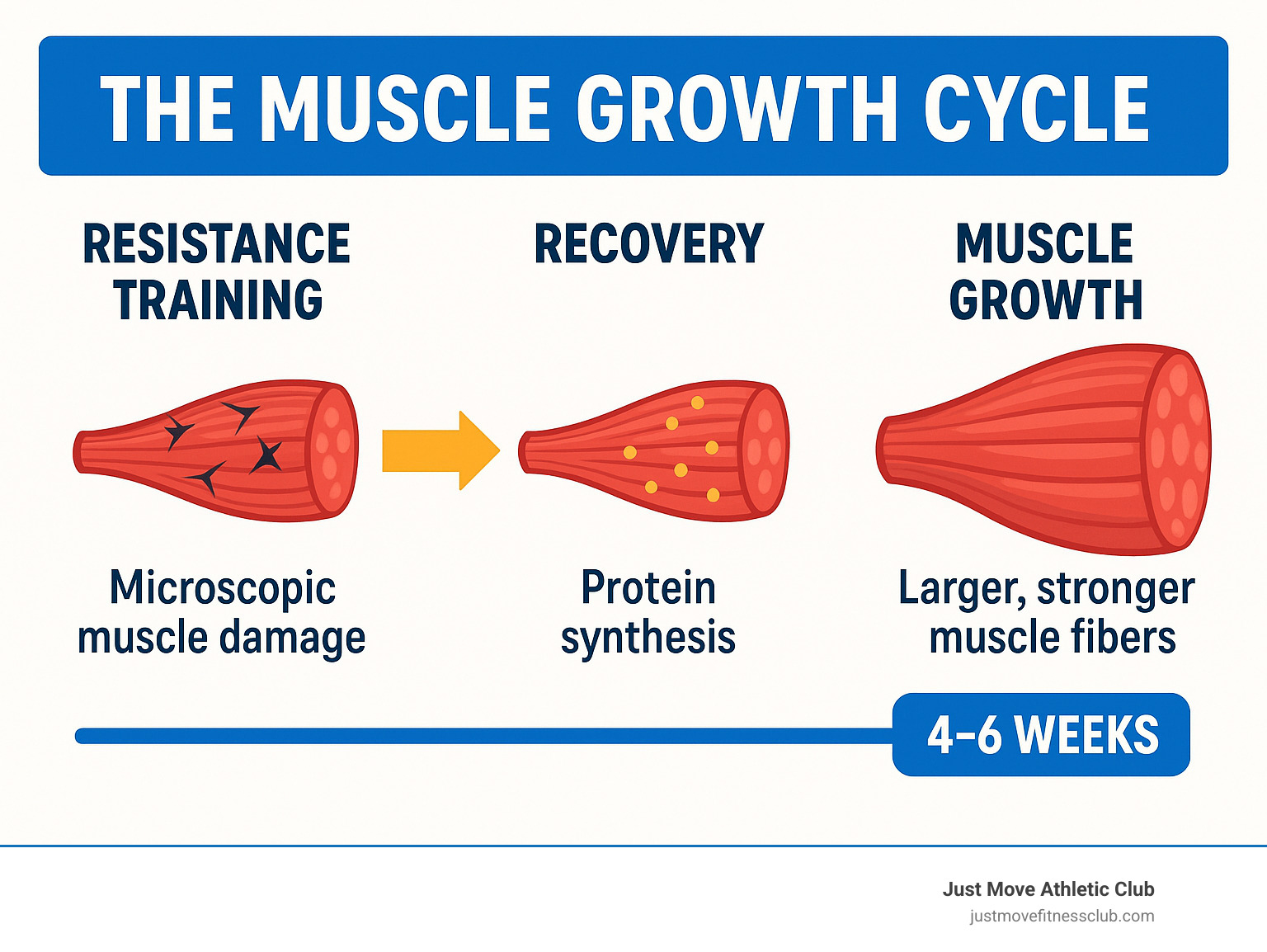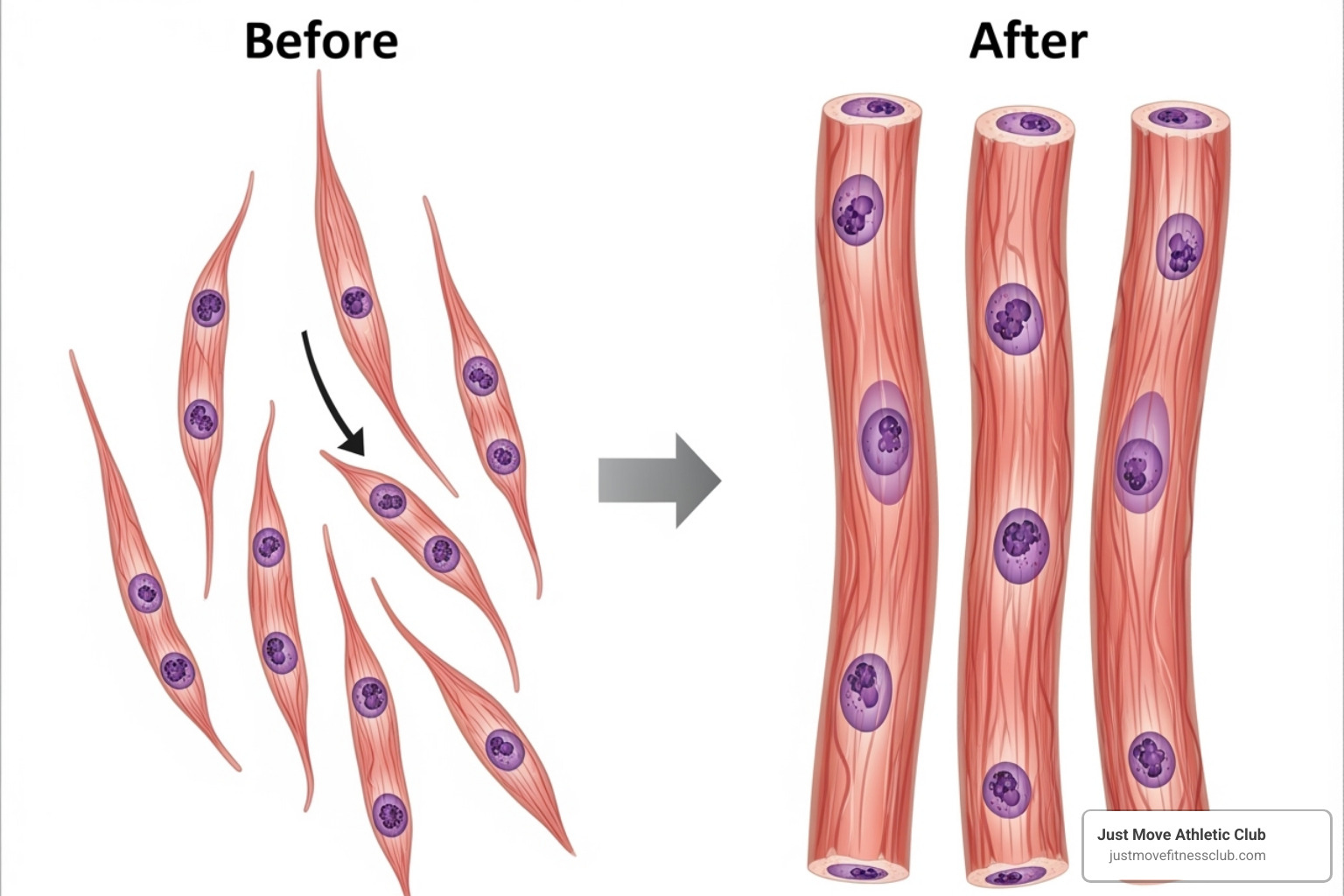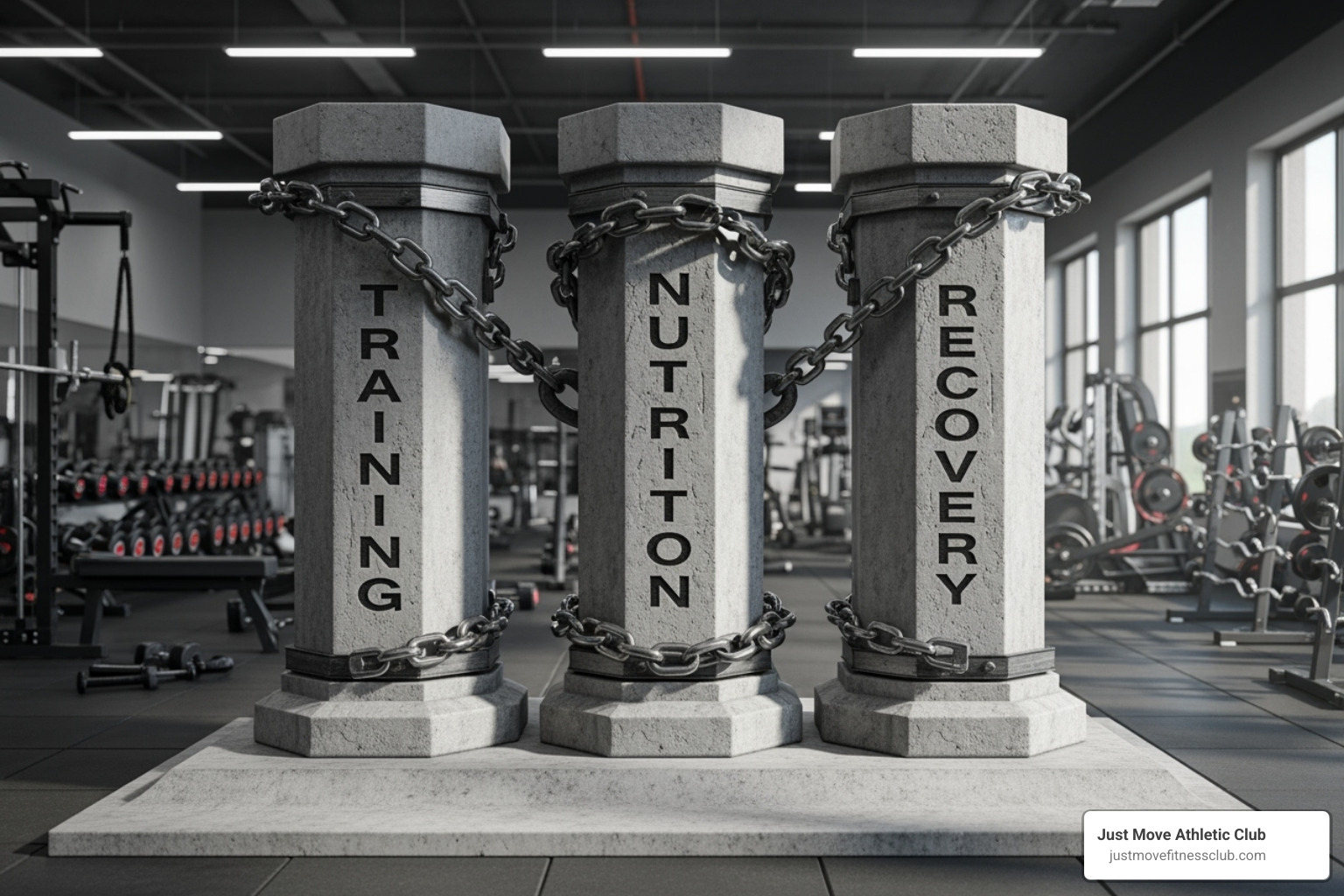Why Gym Muscle Growth Matters for Everyone
Gym muscle growth isn’t just for bodybuilders. Building muscle transforms your body from the inside out, boosting your metabolism, strengthening bones, and making daily life easier. It’s a cornerstone of long-term health, especially since adults can lose 3-5% of their muscle mass per decade after age 30.
Key principles for success include:
- Progressive overload: Gradually increasing the challenge.
- Adequate protein: Fueling muscle repair.
- Consistent training: Hitting each muscle group 2-3 times per week.
- Recovery: Allowing at least 48 hours of rest between sessions for the same muscles.
- Patience: Gains take time, often becoming noticeable after 4-6 weeks.
The science is clear: muscle tissue burns more calories than fat, meaning more muscle boosts your metabolism around the clock. You can see significant improvements with just 20-30 minutes of strength training, 2-3 times per week.
I’m Pleasant Lewis JMAC, founder of Just Move Athletic Clubs. With over 40 years in fitness, I’ve seen how effective muscle-building strategies can change lives at any age.

Relevant articles related to gym muscle growth:
The Science of Muscle Growth: More Than Just Looking Good
When you lift weights, you’re kickstarting a scientific process called hypertrophy. This involves creating tiny, microscopic tears in your muscle fibers. This damage signals your body to repair and rebuild the fibers stronger and larger than before, a process known as muscle protein synthesis. Your body uses protein from food as the building blocks for this repair.
Three key factors drive this process:
- Mechanical Tension: The force placed on muscles from lifting.
- Muscle Damage: The microscopic tears that stimulate repair.
- Metabolic Stress: The “burn” you feel, which helps trigger growth signals.
Hormones like testosterone and growth hormone also play a crucial role, orchestrating the repair and growth process. This is why consistent strength training becomes even more vital as we age and hormone levels naturally change.

Why Build Muscle? The Benefits Beyond the Mirror
While looking good is a great motivator, the benefits of gym muscle growth run much deeper:
- Improved Metabolism: Muscle burns roughly three times more calories at rest than fat does, boosting your metabolism 24/7.
- Increased Bone Density: Weight training puts beneficial stress on your bones, making them stronger and more resilient against fractures and osteoporosis.
- Functional Strength: Everyday tasks like carrying groceries, playing with kids, or climbing stairs become significantly easier.
- Joint Support: Strong muscles act as shock absorbers for your joints, reducing pain and wear and tear.
- Better Blood Sugar Control: Muscle is excellent at using glucose, which can help prevent or manage type 2 diabetes, as shown in scientific research.
- Reduced Injury Risk: Greater strength and stability protect your body during sports and daily activities.
The Pillars of Effective Gym Muscle Growth
Success in gym muscle growth rests on four interconnected pillars: Training (the stimulus), Nutrition (the building blocks), Recovery (when growth happens), and Consistency (the glue that holds it all together). Neglecting any one of these will stall your progress. It’s the synergy between all four that creates lasting change.

Designing Your Workouts for Maximum Gains
Your workouts must be strategic. The golden rule is progressive overload: gradually increasing the challenge over time by lifting more weight, doing more reps, or adding sets. If you don’t challenge your muscles, they have no reason to grow.
- Frequency: Hit each major muscle group at least twice per week for optimal results.
- Volume: A good starting point is 3-4 sets of 8-12 repetitions per exercise.
- Intensity: Train close to muscular failure, where the last few reps are genuinely difficult.
- Exercise Selection: Prioritize compound exercises (squats, deadlifts, bench press) that work multiple muscles at once. Use isolation exercises (bicep curls) to target specific areas.
Both free weights and machines are valuable tools. A balanced approach often yields the best results.
| Feature | Free Weights (Dumbbells, Barbells, Kettlebells) | Weight Machines |
|---|---|---|
| Benefits | – Engage more stabilizing muscles – Promote greater overall strength & coordination – Allow for natural movement patterns – Versatile for many exercises |
– Fixed path, easier to learn form – Safer for beginners or those with balance issues – Can isolate muscles effectively – Often allow for heavier lifting safely |
| Considerations | – Require more technical skill & balance – Higher risk of injury with poor form – May require a spotter for heavy lifts |
– Less activation of stabilizing muscles – Can feel unnatural for some – Limited range of motion compared to free weights – May not fit all body types perfectly |
At Just Move Athletic Club, we see members get fantastic results using a combination of both.
Fueling Your Gains: Nutrition for Muscle Building
Without proper nutrition, your muscles can’t grow. You need a slight caloric surplus (300-500 calories above maintenance) to provide energy for building tissue without adding excess fat.
- Protein: This is non-negotiable. Aim for about 1 gram of protein per pound of body weight daily to repair and build muscle. Excellent sources include lean meats, fish, eggs, Greek yogurt, legumes, and tofu.
- Carbohydrates: These are your primary fuel for intense workouts. Focus on quality sources like whole grains, fruits, and vegetables.
- Healthy Fats: Crucial for hormone production. Include avocados, nuts, and olive oil in your diet.
- Meal Timing: A meal with carbs and protein 1-2 hours before your workout provides energy. A similar meal within an hour after your workout kickstarts recovery. For more detailed advice, consult resources like Sports Dietitians Australia.
The Crucial Role of Recovery
Muscles grow during rest, not in the gym. This is when your body repairs the damage from your workout.
- Rest Days: Give each muscle group at least 48 hours to recover before training it again.
- Sleep: Aim for 7-9 hours of quality sleep per night. This is when your body releases growth hormone and does most of its repair work.
- Active Recovery: Light activities like walking or stretching on off days can improve blood flow and speed up recovery.
- Listen to Your Body: Persistent fatigue or declining performance are signs of overtraining. An extra rest day is sometimes the most productive thing you can do.

Your Muscle-Building Blueprint: Putting It All Together
Now it’s time to create your personal roadmap for gym muscle growth. Success comes from setting realistic goals and tracking your progress. Muscle building is a marathon, not a sprint, so consistency beats perfection every time.
Track your progress with photos, measurements, and a workout log. At Just Move Athletic Club, our members use tools like professional body composition scanners for precise measurements of muscle gain and body composition, which is incredibly motivating.

Tailoring Your Gym Muscle Growth Plan by Experience Level
Your plan should match your experience.
- Beginner: You’ll experience rapid “newbie gains” (1-2 lbs of muscle per month is possible). Focus on mastering form with full-body routines 2-3 times per week, using basic compound movements like squats, deadlifts, and presses.
- Intermediate (6-12+ months of training): Progress slows. Move to split routines like Push/Pull/Legs or an Upper/Lower split to increase training volume and continue making gains.
- Advanced (several years of training): Gains are much slower (perhaps a few pounds per year). Use advanced techniques like drop sets, supersets, and tempo manipulation to break through plateaus.
Common Mistakes That Stall Gym Muscle Growth
Avoid these common pitfalls that I’ve seen countless times over 40 years in the industry:
- Poor Form & Ego Lifting: Lifting too heavy with bad form increases injury risk and reduces muscle stimulation. Focus on quality over quantity.
- Inconsistency: Skipping workouts or constantly changing programs prevents your body from adapting. Stick to a program for 8-12 weeks.
- Neglecting Nutrition & Sleep: You can’t out-train a bad diet or poor recovery. Prioritize protein intake and aim for 7-9 hours of quality sleep.
- Avoiding Compound Lifts: Don’t just do isolation curls. Compound exercises build the strongest foundation.
- Overtraining: More is not always better. Your muscles need time to recover and grow.
Breaking Through Plateaus and How Long It Takes
Expect progress to slow over time. A beginner might see visual changes in 4-6 weeks, while an intermediate lifter’s progress is more gradual. When you hit a plateau, it’s time to change the stimulus.
- Vary your exercises or change your rep ranges.
- Incorporate a deload week every 6-8 weeks, reducing your training volume to allow for full recovery.
Significant muscle growth is measured in months and years. For a deeper dive, this scientific overview of how muscles grow is a great resource. Stay patient and trust the process.
Frequently Asked Questions about Building Muscle
Here are quick answers to common questions about gym muscle growth that I hear from members at Just Move Athletic Club.
How often should I work out to build muscle?
Aim to train each major muscle group at least twice a week, allowing 48 hours of rest for that muscle group to recover. Muscles grow during rest. Consistency is key; three solid workouts a week are better than one marathon session that leaves you too sore to train again.
Can I build muscle and lose fat at the same time?
Yes, especially if you’re a beginner. This process, called body recomposition, is very achievable when you’re new to strength training. For advanced lifters, it’s much more challenging and often requires focusing on one goal at a time. The key for anyone attempting it is a high-protein diet combined with a slight calorie deficit or maintenance intake.
What are the best supplements for muscle growth?
Supplements are not magic. Always prioritize a food-first approach. However, two supplements are well-researched and effective:
- Protein Powder (Whey, Casein, Plant-based): A convenient way to meet your daily protein goals, especially post-workout.
- Creatine Monohydrate: Helps your muscles produce energy for heavy lifting, allowing you to perform better and stimulate more growth over time.
Supplements support a solid training and nutrition plan; they don’t replace it.
Start Your Change Journey
Your gym muscle growth journey starts now. We’ve covered the science, training, nutrition, and recovery. Building muscle is a marathon, not a sprint, but it’s one of the most rewarding things you can do for your health.
Commit to consistency, focus on progressive overload with compound exercises, fuel your body with balanced nutrition, and prioritize adequate recovery. These are the keys to changing your vision of a stronger, healthier you into reality.
At Just Move Athletic Club, we provide a supportive environment for everyone, from beginners to seasoned lifters. Our experienced personal trainers are here to guide you, and our professional body composition scanner takes the guesswork out of tracking your progress. This technology gives you precise data on your muscle gains and body composition changes, offering clear, visual proof that your hard work is paying off.
We’veseen countless members transform their bodies and lives. Your journey starts with the decision to invest in yourself.
Start building muscle with us today – your future self will thank you!
